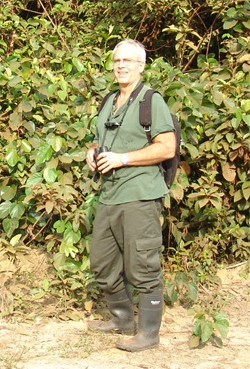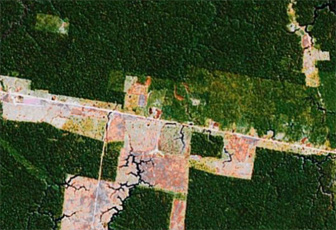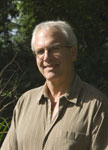Thomas Lovejoy of the H. John Heinz III Center for Science, Economics and the Environment and William F. Laurance of the Smithsonian Tropical Research Institute (STRI) have been awarded one of ecology’s most coveted prizes for their work to understand and conserve the Amazon rainforest.
The BBVA Foundation Frontiers of Knowledge Award in Ecology and Conservation Biology, a prize is given annually to “honor contributions which significantly advance the stock of knowledge in this area for reasons of their importance and originality,” was bestowed upon the scientists for enabling researchers “to measure the manifold consequences of habitat fragmentation for the integrity of tropical forests.” The €400,000-prize is the largest of its kind internationally.
 William Laurance |
The jury’s citation reads as follows:
-
“The awardees are recognized for their contributions to understanding the effects of land use change on biodiversity and ecosystem processes. They have developed and maintained a seminal, long-term landscape experiment in Amazonian Brazil, designed to measure and forecast the manifold consequences of habitat fragmentation – a major consequence of land use change – for the integrity of tropical forests. Their work has revealed many unexpected features of habitat fragmentation, such as dramatically increased mortality in forest trees, with far-reaching consequences for the preservation of forest biodiversity and carbon pool dynamics. Insights from this study have significantly influenced conservation science and practice. The awardees are also applauded for their analyses of the impact of global change phenomena on tropical forests, and for developing the crucial conservation policy mechanism for protecting natural landscapes known as ‘debt-for-nature swaps’.
Understanding forest dynamics after fragmentation
Lovejoy and Laurance launched the Biological Dynamics of Forest Fragments Project (BDFFP) in the late 1970s to measure the impacts of fragmentation on tropical forests. The experiment arose during a period when the Brazilian government was encouraging widespread clearing of rainforest by offering tax incentives to landowners. In an area known as the Manaus Free Zone, just north of the Amazonian city of Manaus, the government required that 50 percent of the forest on a developed area must be saved. Lovejoy used this stipulation for his experiment, convincing landowners to leave their required forest patches in neatly cut squares, ranging in size from 2.5 acres (1 hectare) to 2,500 acres (1,000 hectares).
|
|
The experiment found that the most seriously degraded forest with the least diversity were the smallest, one-hectare reserves, while the reserves that retained the most diversity were the ones of the largest area. In the smaller reserves, drying winds reached the interior, affecting tree species and resulting in more tree falls. Gaps in the canopy allowed more sunlight to reach the forest floor, further altering the understory microclimate and causing changes in the makeup of resident species. Larger herbivores left the patches since the limited number of trees could not provide sustenance, soon followed by predators, which could not cope with the loss of prey. The loss of predators caused an imbalance in the food chain, and the populations of small herbivores and omnivores increased, adding pressure on forest seed banks and impairing the reproducing ability of forest trees. Troops of army ants could not be supported by meager forest patches and they too left, along with the bird, butterfly, and other insect species that depended on the troop. Shade-loving plants and animal species died off as more sunlight penetrated the diminished canopy, and “gap” species, like vines and certain bird and insect species, proliferated. These losses continued to set off a chain reaction that caused profound changes in the system, eventually resulting in its collapse.
Similar experiments carried out around the world have yielded similar results. The colonization of forest patches by forest-edge species, light-gap specialists, and savanna species can counter the loss of species less tolerant of the changed forest and maintain the diversity of the patch. In some cases, forest fragment diversity may hold steady, but overall (global) diversity declines as some unique species lost from the forest patch are not replaced. Declining biodiversity in accordance with decreasing land area is an important trend to consider for conservation.
In global studies, larger forest patches lost fewer of their species. Diversity declined but at a rate and to a degree inversely proportional to the size of the patch. In other words, the larger the patch, the more organisms survived and were successful in reproducing. Thus these experiments demonstrated that the area of an ecosystem directly affects biodiversity.
Growing threats to the Amazon

A fragment of forest surrounded by cleared areas in the Amazon near Manaus. Image courtesy of Google Earth |
Accepting the award on January 30th, Thomas Lovejoy said he was “deeply honored” for being recognized for what was “basically an attempt to understand biological diversity and to ascertain how we can co-exist with the marvelous variety of life to be found in the tropical rainforest”.
“[This is] a fantastic recognition,” added William Laurance.
Both researchers noted that threats to the Amazon have only multiplied since the experiment launched 30 years ago and said that more research is needed to understand changes occurring in the ecosystem due to deforestation and climate change.
“Amazonia is now perilously close to the point of no return,” said Lovejoy, who also serves as a research associate at STRI. “Ecosystem degradation is advancing much faster than we imagined, though we must take hope from the ambitious conservation initiatives that are now starting up.”
“Lately we have observed how this threat is ‘conspiring’ with other pernicious processes like climate change and deforestation,” explained Laurance. “We need to understand how this interaction comes about”.

Markets could save forests: An interview with Dr. Tom Lovejoy
(03/20/2008)
Market mechanisms are increasingly seen as a way to address environmental problems, including tropical deforestation. In particular, compensation for ecosystem services like carbon sequestration — a concept known by the acronym REDD for “reducing emissions from deforestation and degradation” — may someday make conservation a profitable enterprise in which carbon traders are effectively saving rainforests simply by their pursuit of profit. Protecting rainforests and their resident biodiversity would be an unintentional, but happy byproduct of profit-seeking endeavors.

Rainforests face myriad of threats says leading Amazon scholar
(10/17/2006)
The world’s tropical rainforests are in trouble. Spurred by a global commodity boom and continuing poverty in some of the world’s poorest regions, deforestation rates have increased since the close of the 1990s. The usual threats to forests — agricultural conversion, wildlife poaching, uncontrolled logging, and road construction — could soon be rivaled, and even exceeded, by climate change and rising levels of carbon dioxide in the atmosphere. Understanding these threats is key to preserving forests and their ecological services for current and future generations. William F. Laurance, a distinguished scholar and president of the Association for Tropical Biology and conservation (ATBC) — the world’s largest scientific organization dedicated to the study and conservation of tropical ecosystems, is at the forefront of this effort.
Corporations become prime driver of deforestation, providing clear target for environmentalists
(08/05/2008)
The major drivers of tropical deforestation have changed in recent decades. According to a forthcoming article, deforestation has shifted from poverty-driven subsistence farming to major corporations razing forests for large-scale projects in mining, logging, oil and gas development, and agriculture. While this change makes many scientists and conservationists uneasy, it may allow for more effective action against deforestation. Rhett A. Butler of Mongabay.com, a leading environmental science website focusing on tropical forests, and William F. Laurance of the Smithsonian Tropical Research Institute in Panama believe that the shift to deforestation by large corporations gives environmentalists and concerned governments a clear, identifiable target that may prove more responsive to environmental concerns.
